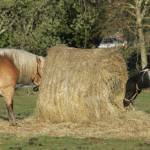Round Bale Feeder Design Affects Hay Waste and Economics

Using round-baled hay is attractive to horse owners because this forage form is less labor-intensive, more convenient, and less expensive than feeding hay in square bales. Some of the drawbacks are excessive hay waste, overconsumption, and weight gain among horses. Several round-bale feeders have been designed to address some of the drawbacks, especially wastage of hay, but to date there have not been any published comparisons.
Researchers in Minnesota conducted an experiment that would measure hay wastage from nine round-bale feeders of differing designs as well as the economics of how long it would take before the feeder would pay for itself in savings related to less wasted hay.
Twenty-five mature Quarter Horse and Thoroughbred mares and geldings with free-choice access to water and a trace-mineralized salt block were fed orchardgrass round bales in nine different commercial round-bale feeders. To test the feeders, the horses were divided into groups of five and then exposed to one of nine different round-bale feeders, or the control of no feeder, for four days. When the horses were switched to a different feeder, they received a new round bale. During the time each group was housed with the hay in the feeder, all the hay on the ground was collected daily, and at the end of four days all the hay left in the feeder was dried and weighed. Care was taken not to include manure and dirt when collecting waste hay. From the savings in hay waste over the control bales, the researchers calculated the number of months it would take to pay for each feeder, using a figure of $112/metric ton for the hay.
During the study all the feeders were found to be safe, although one of the feeders left rub marks on the sides of the horses’ faces. No feeder restricted intake and intakes were similar for all the feeders, ranging from 2% to 2.4% body weight per day. Hay waste differed between round-bale feeder designs and ranged from 5% to 19%, while the waste for the control no-feeder was 57%. There was no significant difference in hay waste among four feeders that had a circular design. In general, more restrictive feeders led to less waste, while feeders that provided more access to the hay resulted in more waste.
Hay-waste savings necessary to pay for feeders varied from less than 1 month to 19 months. This variation was due to the wide range in prices for the feeders ($147 to $3,200).
The results suggest that using round-bale feeders definitely cut the wastage of hay, but the reduction of hay loss for the differing feeders and the time to recoup the cost of the bale feeder is highly variable.
Details on the different types of feeders and more study results can be found here.
This study was presented by Cleary and coworkers at the 2011 Equine Science Society Symposium in Murfreesboro, TN. The proceedings from this symposium are available from the Journal of Equine Veterinary Science (www.j-evs.com).








